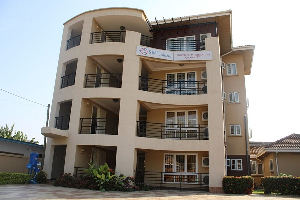- Home - News
- TWI News | TV
- Polls
- Year In Review
- News Archive
- Crime & Punishment
- Politics
- Regional
- Editorial
- Health
- Ghanaians Abroad
- Tabloid
- Africa
- Religion
- Election 2020
- Coronavirus
- News Videos | TV
- Photo Archives
- News Headlines
- Press Release
Entertainment of Wednesday, 4 February 2004
Source: Trevor Clayton, Communications
Restoring Ghana's Highlife
|
|
From his studio in Library and Archives Canada, audio conservator Gilles St-Laurent could reflect comfortably about travelling from Ottawa’s winter weather to Ghana’s sweltering Cape Coast between March 14 and 30, 2003, and his crucial assistance in the development of its Gramophone Records Museum and Research Centre (GRMRC).
"It was a beautiful country with wonderful people, but incredibly hot - high 30s, with humidity…crushing humidity," he recalled.
St-Laurent was the chief technical advisor, purchaser, installer and educator to a small group of Ghanaians who received a $50 000 grant from the Montr?al-based arts and technology benefactor Daniel Langlois Foundation (www.fondation-langlois.org/) to equip themselves for the project. The job was to collect the equipment and organize, catalogue, digitally restore and put online nearly 20 000 records of an all-but-forgotten musical genre.
"Highlife is a style of music that started off in Ghana and is not really recorded anymore because, of course, people’s tastes have changed," explained St-Laurent of the roughly 60-year-old collection. "This is the real stuff and there’s probably no other copies existing anywhere else, and it’s all together under one roof. It’s a very special project."
Approached by Carmelle B?gin, the Canadian Museum of Civilization’s curator of ethnomusicology and an international member of the advisory committee for the GRMRC, St-Laurent spent several months researching before he purchased the equipment from the U.S., flew to Africa and installed the restoration system (computer, record player, playback equalizer, speakers, amplifier, digital analog converters and digital audio workstation).
Together with curator Kwame Sarpong and two students, St-Laurent set to the task of returning an era to the Ghanaian people, and to the world. Eventually, the collection will provide the genesis of Ghana’s National Sound Archive.
All 20 000 records, which date from the British occupation of Ghana between the mid-1930s and late 1950s (a time that saw sophisticated recording equipment brought to the region), belong to Sarpong, an audiophile who initiated the GRMRC project and has been collecting for 35 years.
"It’s his collection, his passion," praised St-Laurent. "Kwame never really had the equipment to play back these records properly. A lot of them he’s now able to listen to for the first time. Some people haven’t heard this music in 50 years."
A CD sampler obtained by St-Laurent of a few of those restored works reveals the Highlife sound as a unique blend of African, black American and Western music using acoustic rhythm guitars, vibrant percussion, vocal harmonies and repetitive patterns. A collection of approximately 1 000 songs will comprise the first online offering, hopefully to be completed in a year’s time.
The difficult procedure of restoring extremely old and rare records begins with extensive cleaning of the record’s surface using a record-cleaning machine and recording a 24-bit unfiltered version (including hisses, pops and all) onto the computer. This version, once burned onto CD-ROM, becomes the "conservation copy." From the 24-bit version on the computer, advanced digital audio processing is applied to remove as much noise as possible while striving to find a good balance between removing noise and adversely affecting the sound through over-processing. From this digitally re-mastered version, a 16-bit audio CD is burned which then becomes the consultation copy and the copy to be used on the Web site.
"I taught the staff how to use the system and the theory behind it," said St-Laurent, adding that the museum’s broken air conditioner kept him broiling in the perpetual African humidity and drinking four litres of water everyday for all but the last leg of his trip. "They caught on really quickly. By the end of the two weeks I was confident that things were in good hands."
St-Laurent’s confidence certainly lends credibility to any audio conservation initiative. In 2002, he was presented with England’s prestigious CEDAR award for his restoration work on a 1931 recording of La Chanson du bavard, sung by Madame ?douard Bolduc, and in 1998 played a pivotal role in introducing the Library’s Virtual Gramophone, a multimedia Web site devoted to the first half-century of recorded sound in Canada.
"I was able to use my experience here on the Virtual Gramophone to teach them how to manage all the various elements of the project," he said. Both of St-Laurent’s students were music scholars from the University of Cape Coast. One was completing his master’s degree and the other heading towards a career in music education.
St-Laurent remains committed to working with Sarpong, should any technical problems arise, and will perhaps return to Ghana in the future.
His impressions of Ghana were captured in the several rolls of film he brought back from the adventure. St-Laurent is an avid amateur photographer, and his images reveal a plethora of cultural perspectives: breathtaking countryside, a 17th-century slave fortress (Elmina Castle) and quaint, ocean-side fishing villages are contrasted with roads full of "potholes into which elephants could disappear" and taxis, with broken windshields and no seatbelts, spewing black smoke.
Perhaps the most extraordinary occurrence (for which there are no pictures) was a false bomb threat at the beginning of the trip on the runway in Montr?al, an event that forced everyone onboard the plane to disembark and be scrutinized by dogs; St-Laurent missed his connecting flight in Frankfurt to Lagos, Nigeria (he would eventually reach Accra after an extra stop in Milan). He arrived in Ghana seven hours late and without any luggage, but remained steadfast, like a 78.
By sharing and exchanging expertise with knowledge professionals throughout the world, Library and Archives Canada is helping to make the cultural heritage of the world’s nations more accessible to its peoples.














